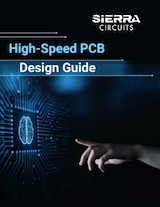
|
FreeComputerBooks.com
Links to Free Computer, Mathematics, Technical Books all over the World
|
|
- Title: High-Speed Printed Circuit Board (PCB) Design Guide
- Authors Amit Bahl
- Publisher: Sierra Circuits
- Hardcover: N/A
- eBook: PDF
- Language: English
- ASIN: N/A
- ISBN-10: N/A
- ISBN-13: N/A
- Share This:

|
This book addresses the high-speed Printed Circuit Boards (PCBs) design challenges and the best practices to be followed to meet those challenges. Designing an optimum PCB that is manufacturable requires immense practical experience.
About the Authors- N/A

- High-Speed Printed Circuit Board Design Guide (Amit Bahl)
- The Mirror Site (1) - PDF
- The Mirror Site (2) - PDF
-
 Designing a Printed Circuit Board (PCB) with EAGLE eCAD/CAM
Designing a Printed Circuit Board (PCB) with EAGLE eCAD/CAM
This thoroughly revised, easy-to-follow guide shows, step-by-step, how to create your own professional-quality Printed Circuit Boards (PCBs) using the latest versions of EAGLE eCAD/CAM.
-
 Introduction to Printed Circuit Board (PCB) Design
Introduction to Printed Circuit Board (PCB) Design
This book is interesting for Printed Circuit Boards (PCB) design as it covers everything from basics of PCB design to advance topics with clear and concise explanations with practical examples.
-
 Electrical Circuit Analysis (Jim Pytel)
Electrical Circuit Analysis (Jim Pytel)
This book has been written for students on electrical engineering courses who don't necessarily possess prior knowledge of electrical circuits, based on the author's own teaching experience.
-
 Digital Integrated Circuits: A Design Perspective (Jan M. Rabaey)
Digital Integrated Circuits: A Design Perspective (Jan M. Rabaey)
Progressive in content and form, this practical text successfully bridges the gap between the circuit perspective and system perspective of digital integrated circuit design. Focuses on practical design issues, with examples, design problems and case studies.
-
 Intelligent Circuits and Systems (Rajesh Singh, et al)
Intelligent Circuits and Systems (Rajesh Singh, et al)
Explored recent innovations of the development of smart and green technologies in the fields of Energy, Electronics, Communications, Computers, and Control. Provides innovators to identify new opportunities for the social and economic benefits of society.
-
 Lessons in Electric Circuits (Tony R. Kuphaldt)
Lessons in Electric Circuits (Tony R. Kuphaldt)
A 6 volumes series of textbooks on the subjects of electricity and electronics. This book was written to be a good enough book without delving too heavy on the math, while still maintaining a lot of important information.
-
 DC Electrical Circuit Analysis: A Practical Approach (James Fiore)
DC Electrical Circuit Analysis: A Practical Approach (James Fiore)
Basic concepts are introduced such as charge, current, energy, power and voltage. Covering analysis techniques such as superposition, source conversions, mesh analysis, nodal analysis, , Thévenin's and Norton's theorems, and delta-wye conversions, etc.
-
 AC Electrical Circuit Analysis: A Practical Approach (James Fiore)
AC Electrical Circuit Analysis: A Practical Approach (James Fiore)
Cover topics including series, parallel, and series-parallel RLC circuits. Numerous theorems and analysis techniques are examined including superposition, Thévenin's theorem, nodal and mesh analysis, maximum power transfer and more.
-
 Circuit Theory (WikiBooks)
Circuit Theory (WikiBooks)
The aim of this book is to assist students in understanding the basic concepts of circuit theory and developing the fundamental tools of linear circuit analysis, which will be useful for all engineers.
-
 AC Circuits (Chad Davis)
AC Circuits (Chad Davis)
This book covers Alternating Current (AC) circuit theory as well us a brief introduction of electronics. It covers the basic theory of AC signals, sinusoidal waveforms, square waves, triangle waves, the mathematics background, resistors, inductors, and capacitors.
-
 DC Circuits (Chad Davis)
DC Circuits (Chad Davis)
This book covers Direct Current (DC) circuit theory: The basics for circuits that include DC sources (voltage or current) and resistors; Problem solving techniques for circuits that include only DC sources and resistors; Capacitors and inductors.
-
 An Introduction to Electronics (WikiBooks)
An Introduction to Electronics (WikiBooks)
The aim of this book is to explain the design and function of electronic circuits and components. It covers electronic circuit components, DC analysis, and AC analysis, and provides readers with a broad overview of both the linear and digital fields of electronics.
-
 Semiconductor Devices: Theory and Application (James M. Fiore)
Semiconductor Devices: Theory and Application (James M. Fiore)
Covers the theory and application of discrete semiconductor devices including various types of diodes, bipolar junction transistors, JFETs, MOSFETs and IGBTs. Applications include rectifying, clipping, clamping, switching, small signal amplifiers and followers.
-
 Designing Analog Chips (Hans Camenzind)
Designing Analog Chips (Hans Camenzind)
A comprehensive introduction to CMOS and bipolar analog IC design. The book presumes no prior knowledge of linear design, making it comprehensible to engineers with a non-analog background.
-
 Operational Amplifiers and Linear Integrated Circuits
Operational Amplifiers and Linear Integrated Circuits
This book offers an extensive and detailed exploration of the modern op amp and associated specialized linear integrated circuits. The exploration begins with a fundamental building building block, the differential amplifier.
-
 A Pragmatic Introduction to the Art of Electrical Engineering
A Pragmatic Introduction to the Art of Electrical Engineering
This book provides a solid overview of the electrical engineering discipline that is especially geared toward the many non-electrical engineering students. It uses of practical applications to illustrate important principles.
-
 Understanding Electronics Components (Filipovic D. Miomir)
Understanding Electronics Components (Filipovic D. Miomir)
This book is meant for those people who want to create electronic devices with their own hands. All components are illustrated and the circuit-symbol is explained in detail. Both simple and complex examples are provided for the beginners.
-
 Application-Specific Integrated Circuits (Michael J. Smith)
Application-Specific Integrated Circuits (Michael J. Smith)
This comprehensive book on application-specific integrated circuits (ASICs) describes the latest methods in VLSI-systems design. It covers both semicustom and programmable ASIC types.





